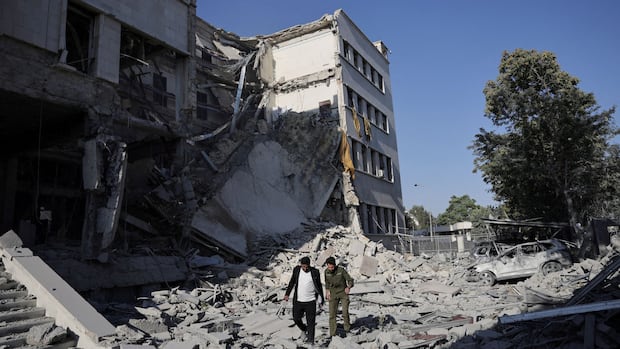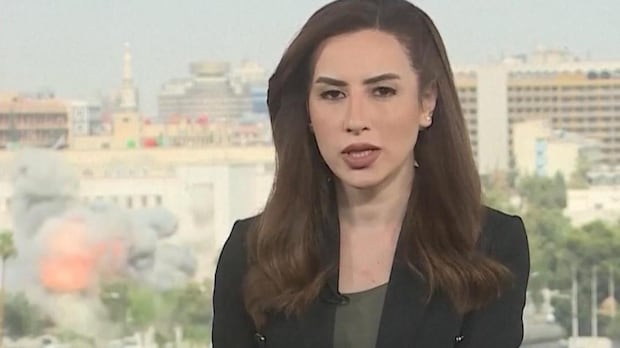Syria’s new government grappled with deadly clashes in the southern part of the country over the past week between local Bedouin fighters and militias linked to the Druze minority people. Then, Syrian government forces intervened in the region, causing further bloodshed.
A halt to the fighting was declared on Wednesday — but that happened only after a wave of Israeli airstrikes on Syria’s capital city, Damascas.
Convoys of Syrian government forces reportedly withdrew overnight Wednesday from the Suwayda governorate (an administrative region similar to a state) as part of the ceasefire agreement. Suwayda, one of 14 governorates in Syria, is mainly populated by Druze people.
Here’s what we know about what caused the deadly violence to erupt in the region, why both Syria and Israel intervened, and the role of the Druze people in this situation.
Who are the Druze?
The Druze religious sect began as a 10th-century offshoot of Ismailism, a branch of Shia Islam.
They make up roughly three per cent of Syria’s population. But more than half of the roughly one million Druze worldwide live in Syria.
Most of the other Druze live in Lebanon and Israel — including in the Golan Heights, which Israel captured from Syria in the 1967 Arab-Israeli War and annexed in 1981.
The local Druze in Suwayda, who make up 90 per cent of the region’s population, largely expelled the ousted former president Bashar al-Assad’s regime and its agents in 2012. After that, they aided neither Assad’s government nor the rebels opposing him.
The community, which is split into a number of factions, had been divided over how to approach Syrian leader Ahmed al-Sharaa’s de facto Islamist rule over Syria after largely celebrating the downfall of the decades-long dictatorial rule of the former regime in December 2024.
They feared persecution after several attacks from the Islamic State militant group and al-Qaeda affiliates, the Nusra Front, in the 14 years following the uprising against the regime in Syria in March 2011.
While it first appeared many Druze hoped to resolve matters diplomatically, with al-Sharaa vowing to create an inclusive Syria for all its different ethnic and religious communities, they became more skeptical over time, especially after a February counter-insurgency in the coastal province turned into targeted attacks against the Alawite religious minority.
What fuelled the violence in Suwayda?
While a previous truce between Druze armed groups and government forces appeared to be holding, state media reported that Druze militants had launched revenge attacks in the last several days on communities of Sunni Bedouins, leading to a wave of displacement.
Clashes escalated over the weekend after a Druze merchant was reportedly abducted. This was followed by tit-for-tat kidnappings and attacks between local Sunni Bedouin tribes and Druze armed factions in Suwayda.
Government forces that intervened to restore order clashed with the Druze militias and also attacked unarmed civilians, according to witness reports.
The Syrian Network for Human Rights (SNHR) said it had documented 193 deaths in four days of fighting. Medical personnel, women and children were among the victims.
Fadel Abdulghany, SNHR executive director, said the figure included cases of field executions by both sides — Syrians killed by Israeli strikes and others killed in clashes — but said it would take time to break down the figures for each category.
Video also circulated on social media showed government forces and allies humiliating Druze clerics and residents, looting homes and killing civilians hiding inside their houses.
Government fighters reportedly looted and burned homes in Suwayda, then left. Fighters also shaved off mustaches, which are a symbol of religious and cultural identity with spiritual significance for many Druze men and sheikhs.
In March, a pro-Assad uprising saw violent clashes between the army and pro-Assad loyalists in the western coastal region. It turned deadly, with hundreds killed, including unarmed civilians from the Alawite sect, an offshoot of Shia Islam. Most recently, an ISIS bombing at a church in Damascus killed dozens of churchgoers, fuelling fear of instability in the region.
Why is Israel involved?
Israel, which bombed Syria frequently under the rule of Assad, has struck the country repeatedly this year.
Its latest airstrikes on Wednesday blew up part of Syria’s Defence Ministry and hit near the presidential palace as Israeli officials vowed to destroy government forces attacking Druze.
Israeli Prime Minister Benjamin Netanyahu took credit on Thursday for the ceasefire, and vowed to keep southern Syria demilitarized.
“We will not allow military forces to descend south of Damascus, we will not allow the Druze to be harmed in Jebel Druze,” he said.
Syria’s interim president Ahmed al-Sharaa accused Israel on Thursday of trying to fracture Syria and promised to protect its Druze minority, after U.S. intervention helped end deadly fighting between government forces and Druze fighters in the south. This came after Israel launched airstrikes in Damascus on Wednesday.
Since the fall of Assad, Israel has emerged as a new power broker in southern Syria, moving troops across the longtime frontier to occupy territory and raid villages.
Scores of Israeli Druze broke through the border fence on Wednesday, linking up with Druze on the Syrian side, despite Netanyahu urging Israeli Druze citizens not to cross the border.
Al-Sharaa accused Israel of trying to fracture Syria on Thursday, saying it sought to “dismantle the unity of our people” and had “consistently targeted our stability and created discord among us since the fall of the former regime.”
How did the new Syrian government respond?
Al-Sharaa, who was commander of an al-Qaeda faction before cutting ties with the group in 2016, said protecting Druze citizens and their rights was “our priority” and rejected any attempt to drag them into the hands of an “external party.”
He also vowed Thursday to hold to account those who committed violations against “our Druze people,” after Druze leaders and Syrian government officials reached a ceasefire deal a day earlier, mediated by the United States, Turkey and Arab countries.
Under the new agreement, Druze factions and clerics have been appointed to maintain internal security in Suwayda, al-Sharaa said in an address broadcast Thursday.
A TV news anchor in Syria was on air when an Israeli strike hit the Ministry of Defence in Damascus on Wednesday, badly damaging the building near the presidential palace.
Samy Akil, a non-resident fellow at the Washington, D.C.-based Tahrir Institute for Middle East Policy, said there is division within the Druze community because of its numerous factions. He added that Israel is trying to exploit it for their own interests by strong-arming the Syrian government in its military intervention.
“Druze do not have one unified leadership. If you were to ask Druze civil society which of the factions actually represent them or has the most support, they would tell you none of them,” Akil said.
“But Israel is trying to use the Druze card to kind of create divisions and sow divisions within Syrian society, which at the end of the day, if it has a policy which is driven off by keeping Syria weak and fragile and divided — that is the only rationale for it intervening yesterday and in the days before.”
Fear of violence erupting again
But seeds of mistrust have already been sown, and efforts like the renewed truce deal and government vows to protect its minority groups are too little, too late, some experts say.
“The issue is that the Syrian government has failed to live up to its expectations of being a government that can safely protect all of its citizens,” Akil said in an interview with CBC News Thursday.
“The situation has not been resolved. I fear that there will be a second phase in the days and weeks to come.”
Deadly clashes in Syria’s southern province of Suwayda show the new regime is incapable of protecting all Syrians, including its minorities, says Samy Akil, a non-resident fellow at the Washington, D.C.-based Tahrir Institute for Middle East Policy. Dozens have died after Syrian government officials tried to intervene following attacks between local Bedouin fighters and militias linked to the Druze minority over the last week, prompting Israeli airstrikes on Damascus Wednesday.
Akil said that while the new Syrian government has made some gains, including the removal of suffocating Western sanctions placed on the country under the rule of Assad, it has failed to prioritize domestic security.
“There has been too much effort on foreign relations and not enough attention to domestic tensions that have been rising up,” he said.
While the government has been saying “many of the right things,” to unite communities, it has ultimately failed to “walk the talk,” he said.
Issam al-Reis, a senior military adviser with Etana, a Syrian research group, said the lack of “effective state-led negotiations” could sow further divisions between the Druze community and the Sunni Bedouins, who were largely able to coexist.
“This is leading to militant sectarianism, which is dangerous,” he told Reuters, adding it’s a sign that the government needs to speed up its integration of other sects into the Syrian army, which could make it a more unifying force and help resolve sectarian tensions.
“There have been agreements and talks about this with different communities, but until now, none of this has been implemented,” he said.


